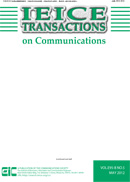All issues

Volume E91.B, Issue 5
Displaying 51-55 of 55 articles from this issue
Regular Section
-
Hyung-Rae PARK, Young-Ho YUNArticle type: LETTER
Subject area: Wireless Communication Technologies
2008 Volume E91.B Issue 5 Pages 1657-1660
Published: May 01, 2008
Released on J-STAGE: March 01, 2010
JOURNAL RESTRICTED ACCESSIn this letter we propose an adaptive beamforming algorithm that efficiently suppresses interferences using a structured interference covariance matrix. The proposed algorithm provides high performance by exploiting angle diversity, especially in cellular mobile environments where the angular spread of a received signal is relatively small. We verify the superiority of the proposed algorithm to the well known linearly constrained minimum variance (LCMV) and reference signal-based algorithms.View full abstractDownload PDF (676K) -
Yi LONG, Linling KUANG, Jianhua LUArticle type: LETTER
Subject area: Terrestrial Radio Communications
2008 Volume E91.B Issue 5 Pages 1661-1664
Published: May 01, 2008
Released on J-STAGE: March 01, 2010
JOURNAL RESTRICTED ACCESSThis letter proposes a novel intercarrier interference (ICI) mitigation method for OFDM in time-varying multipath channels. By splitting an OFDM symbol into sub-symbols, ICI may be relieved but with price of increased inter-subsymbol-interference (ISI). The induced ISI is then cancelled by a linear filter with the use of null subcarriers. Simulations show that the proposed method may effectively mitigate ICI while improving OFDM with enhanced reliability against high Doppler spread.View full abstractDownload PDF (723K) -
Sungjoon LIMArticle type: LETTER
Subject area: Antennas and Propagation
2008 Volume E91.B Issue 5 Pages 1665-1668
Published: May 01, 2008
Released on J-STAGE: March 01, 2010
JOURNAL RESTRICTED ACCESSA dispersion diagram is useful in interpreting the characteristics of a periodic structure. In particular, the fast-wave region, where the wave is radiating, and the slow-wave region, where the wave is guided, can be determined from the dispersion diagram. An electronically-controlled composite right/left-handed (CRLH) transmission line (TL) was previously proposed and utilized as a leaky-wave (LW) antenna operating in the fast-wave region. However, since a guided-wave application operates in the slow-wave region, it is meaningful to study slow-wave effects of the proposed TL. In this paper, the dispersion diagram is used to investigate the slow-wave factor (SWF), which is necessary to understand the fast/slow-wave operations. Furthermore, the frequency characteristics are measured to find the cut-off frequencies in the LH and RH regions. Based on experimental results, it is observed at a fixed frequency, 2.6-GHz, that the phase of a proposed 6-cell structure can be changed by up to 280° in the LH slow-wave region.View full abstractDownload PDF (1696K) -
Takafumi FUJIMOTOArticle type: LETTER
Subject area: Antennas and Propagation
2008 Volume E91.B Issue 5 Pages 1669-1672
Published: May 01, 2008
Released on J-STAGE: March 01, 2010
JOURNAL RESTRICTED ACCESSA stacked square microstrip antenna with shorting plates is proposed for wide band operation. The vswr≤2 with gain at θ=0°≥0 dBi is achieved in the frequency range between the first and second resonant frequencies by loading the two shorting plates. The proposed antenna has bandwidth of approximately 60%.View full abstractDownload PDF (1290K) -
Ki-Won KWON, Yongsoo CHOArticle type: LETTER
Subject area: Broadcast Systems
2008 Volume E91.B Issue 5 Pages 1673-1676
Published: May 01, 2008
Released on J-STAGE: March 01, 2010
JOURNAL RESTRICTED ACCESSThis letter presents a simple joint estimation method for residual frequency offset (RFO) and sampling frequency offset (STO) in OFDM-based digital video broadcasting (DVB) systems. The proposed method selects a continual pilot (CP) subset from an unsymmetrically and non-uniformly distributed CP set to obtain an unbiased estimator. Simulation results show that the proposed method using a properly selected CP subset is unbiased and performs robustly.View full abstractDownload PDF (508K)